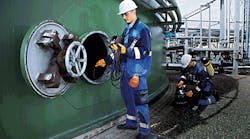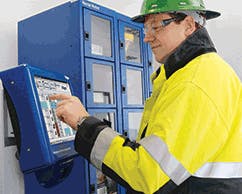Each year, companies look back to assess and review their current status to help position themselves for a safer, more efficient and promising future. Technology, training and talent particularly are interconnected and essential to creating safe and efficient worksite operations. This evaluation allows organizations to set realistic and obtainable goals that management and onsite workers can work toward.
In order to realize areas of improvement and weakness, corporate leaders should consider asking themselves the following questions during a worksite appraisal. (While these questions lay a strong foundation, they are a starting point, and further investigation often is necessary to complete a comprehensive evaluation.) Questions to consider include:
- What part of the safety system does not appear to be performing at full capacity, and how can it effectively and efficiently be addressed?
- Is there a pattern or trend of incidents/near misses (slips, trips and falls, chemical spills, exposure concerns in one area, etc.)?
- If a pattern does exist, how did the company respond? What corrective actions were implemented? Were these actions effective in mitigating future risk or the root cause?
- What training and educational seminars stood out in workers' minds and why?
- How can future training events and activities leverage these findings?
It is through a combination of quantitative and qualitative evaluation that a company can gain a complete snapshot of the productivity and challenges of a worksite. Through these indicators, companies should measure against their strategic priorities to ensure better safety procedures and an increasingly engaged workforce in the coming year.
Understanding the Technology
A strong component of this evaluation is taking a closer look at a company's equipment portfolio to determine where improvements are viable. With the rapid rate at which technological advancements are introduced to the industry, this assessment allows corporate and safety leaders to review new technologies that can make the greatest difference in their workflow, worker safety and ultimately, impact training and talent (the other two Ts).
The global oil and gas mobility market is estimated to grow to $25.99 billion by 2022, underscoring the increasing rate at which companies are moving away from the manual operations of the past and investing in digital systems to keep pace with competition. Mobile devices are vital drivers of efficiency because they provide instant access to critical data while bridging communication gaps and reducing the potential for hazardous events to arise.
Not only do these mobile systems proactively monitor for danger, but they also capture copious amounts of information, which can be relayed to a central hub and serve as a predictive mechanism. Regulatory agencies can use these large aggregations of data to examine processes, determine patterns and forecast future outcomes, all of which can aid federal agencies in their decision-making process in enacting enhanced safety regulations.
Furthermore, an option like a set of secured lockers can provide workers on-demand access to fully serviced equipment such as gas detectors, masks or personal protective equipment (PPE) like hearing or eye protection, at central supply points throughout a facility. Employees wishing to pick up their PPE can simply log on at the "service station" any time, using a barcode or radio frequency identification. Based on the respective user data, the device identifies which products the employee can access and displays those pieces of equipment on a screen. Optional information on the products' performance range also can be displayed in some cases.
Often these devices have a central network connection that tracks the location, status (calibration and level of charge for monitors, for example) and returns. This adds a significant cost-savings layer to a company's safety plan, as more time is spent on tools and less on maintaining or replacing equipment.
Committing to Training
Training is an essential component to any company's safety plan, but it is essential to those operating in high-risk industries. For example, oil and gas extraction industries experienced a 27 percent increase in fatalities, rising from 112 in 2013 to 142 in 2014 (U.S. Bureau of Labor Statistics).
As previously mentioned, the rate at which technology evolves begs for greater investment in education and safety training. It is imperative that the entire company hierarchy has an appropriate understanding of potential hazards and how to safely use onsite equipment; when a training program is used both as a tool for company growth and a method to prevent loss of life it displays a 360-degree benefit.
It's important that corporate leaders recognize obstacles inhibiting deeper education and work toward producing engaging and educational training sessions to build and fill their workers' knowledge well. Organizations should consider routine, hands-on training sessions where employees are encouraged to pre-test equipment before using it in the field. This training allows workers to better understand the equipment they rely on, helping to mitigate the potential for future errors. Consider the following methods to create engaging training sessions:
- Show workers how to stay safe to provide clarity in the training.
- Encourage workers to share experiences.
- Promote meaningful discussion and take note of worker suggestions.
- Emphasize the importance of questions.
In addition to regularly scheduled sessions, organizations should consider providing updates on new and modified OSHA standards during this time, which can help tie the importance of understanding proper equipment function and maintenance to regulations designed to prevent injury or loss of life. Implementing a system like this can help companies monitor which employees are up-to-date on safety rules and regulations, and provide a platform to voice any questions or concerns before entering the field.
Attracting and Retaining Top Talent
Finally, while the proper technology and proper training are vital tools in an organization's tool kit, the proper people must be in place to execute your corporate vision. In an industry where the most important and limited resource is its workforce, the demand and competition for highly-skilled, educated and specialized individuals is at an all-time high. Undoubtedly, safety for workers across the board is one of the most important results of a comprehensive training program, and a strong record can increase the attraction and loyalty personnel may feel toward an organization.
From a management perspective, recognizing employees' motivation and drive to improve their working skills and foundational knowledge helps generate a community committed to safety. This acknowledgement of top talent likely will perpetuate the development of personal growth and safer habits in other employees as well. In turn, employees who invest in continuing their professional development can increase their professional equity. Through increasing their value to an employer, these employees can achieve leadership roles within the organization and help it grow in a direction that is smarter, profitable and most importantly, safer.
In an industry that relies on a knowledgeable, well-trained workforce for success, oil and gas companies are poised to successfully embrace the three Ts.
Robb Zurek is marketing manager, oil & gas and chemical segments, for Dräger, which is based in Lübeck, Germany. He can be reached at [email protected].

